Tibial Plateaux Levelling Operations (TPLO)
What’s involved and what are the benefits?
The surgery involves cutting the tibia and flattening the tibial plateaux to around 3 to 5 degrees. The cut ends of the tibia are then held together to heal with bone plates. This healing will take up to 3 to 4 months and so the post operative rehabilitation is important and takes around 12 weeks.
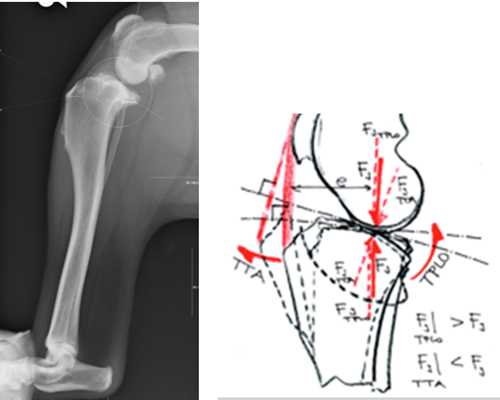
What are the advantages?
There have been many studies into Cranial Cruciate Ligament (CCL) disease and the different methods of addressing it, the wide variation in presentation and the wide variation in individual patient factors mean that we still have a number of options available but for the vast majority of patients we see the TPLO as the best treatment option available. A study from the US has shown that the outcome of patients after 6 months having had TPLO is consistently better than the outcomes for patients having had TTA or lateral suture techniques.
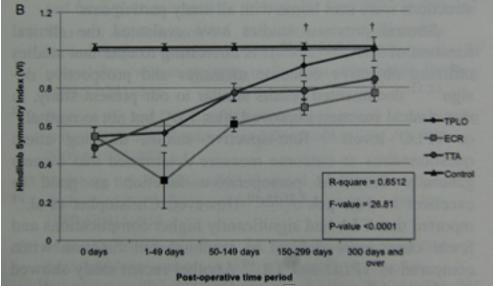
It is important to note that every case that has a TPLO will always have a joint examination first, this is a vitally important step and at Ridge Referrals we feel that arthroscopy is without doubt the best way to do this. There are a small number of cases that we see where the arthroscopic examination dictates that the TPLO will not provide benefit and in some cases we need to be certain of the diagnosis (for example a very early cruciate problem) in order to confirm that a TPLO is the correct thing to do.
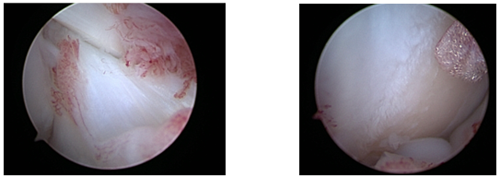
Arthroscopic pictures from two very different cases showing an early cruciate tear that justifies a TPLO and an advanced medial femoral condyle injury that means the TPLO will not help.
Internally braced TPLO
In some dogs the cruciate ligament fails very suddenly and the knee becomes very unstable, in this instance we may need to add a second stabilising procedure to the TPLO in order to provide stability in all planes. We were the first practice in Europe to use the Arthrex Internal Bracing system and the use of the Arthrex TPLO plate allows us to employ this for any case we feel is needed. The procedure involves making a further incision in order to place a very strong Internal Brace suture and not every case needs it. However in those cases that do have very unstable knees we have found that the recovery faster and the eventual function better if we do add the suture. Ridge Referrals is one of only a few practices that can offer this treatment in the UK.
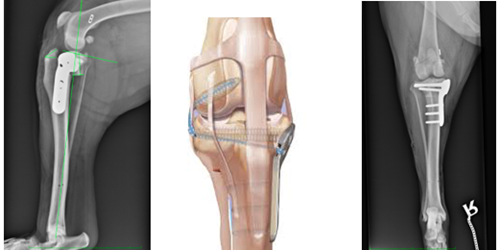
Complications
This is a major surgical procedure that involves cutting the tibia, as a result there can be major complications. Allowing your dog to over exercise, lick the wound, jump onto sofas and furniture, run up and down stairs etc can lead to significant complications that can be time consuming, involve further surgeries and extra costs to you. The recognised complication rate is as high as 5 to 10% (that need further surgery), in our last audit of TPLO cases (2019) our major complication rate (those that needed a second surgery) was 3%, these include infection around 2% and implant related issues around 1%.
Post operative infections:
Every possible effort is made to reduce the possibility of wound infection. We use completely disposable drapes, gowns, gloves and skin barrier preparations. All surgeries are performed in our dedicated theatre. Staff wear theatre scrub suits, hats, masks and footwear, attention to detail in theatre and theatre practice is paramount. Dedicated powered equipment is used for the surgery. Intravenous antibiotics are given during. The wound is covered with a sterile dressing and a Buster Collar is mandatory until the sutures have been removed. Still a small number of patients will have problems with post -operative infections, on the whole these are 3 to 4 weeks after surgery and restricted to soft tissues around the site but joint infections and infections of the plates and screws do still occasionally occur.
Delayed healing, malunion or non healing of the osteotomy:
Again every effort is made to create an optimal environment for healing of the osteotomy. We use almost exclusively the Arthrex TPLO plate and locking screw system. This is an extremely robust fixation system and in some cases we may add a second plate. Strict rest is essential after the surgery whilst the bone heals and that is why caged rest is mandatory for 6 to 8 weeks post op. The healing of the osteotomy is checked at this time and provide there are good signs of bone healing then controlled exercise is gradually built up.
Late meniscal injury:
This may occur any time after the procedure but often seems to occur after 6 weeks. The use of arthroscopy to inspect the menisci has been shown to reduce this complication, we use arthroscopy as a standard which makes our charge higher but we feel that this represents the gold standard in joint assessment. Our rate of late meniscal injury in the latest audit was zero however in past cases not included in this audit (a different plating system) late meniscal injury can be simply addressed by arthroscopic surgery.
Haemorrhage
A rare but potentially life threatening complication is profuse bleeding during surgery due to laceration of the popliteal artery. Studies have shown that using a less invasive approach and careful attention to detail should make this complication very unlikely. The risk of this complication is extremely low.
Patella tendon desmitis:
In this instance the patella tendon becomes painful because of the altered joint mechanics. It generally settles with time without specific treatment.
Post operative swelling:
All cases are kept in for 24 hours after the surgery and occasionally two nights. This allows us to ensure they are having sufficient pain relief and start regular icing. Some swelling around the hock is sometimes observed within a few days of going home. This resolves with some gentle massage and time.
Post operative pain:
All cases stay in for 24 to 48 hours post op to ensure they receive sufficient pain relief, this will include Non Steroidal Anti Inflammatories (NSAIDs), opiates (morphine) and local anaesthetics as needed. Sometimes cases may stay in longer if need be.
What can I expect post op?
- The surgical site will be covered with a sterile dressing. Your dog will be wearing a Buster Collar and this must be worn 24/7.
- It is quite common to see some swelling develop around the hock, this is the normal process of bruising accumulating dependently and provided your dog is not uncomfortable this is not a worry.
- Your dog must not be allowed to exercise freely at all outside. Restriction to a cage for the first 6 to 8 weeks is essential. Lead toilet exercise is all that is allowed.
- The wound should be checked by your vet 3 to 4 days after going home.
- 14 days after the surgery your dog should be checked again by your vet to remove any skin sutures and check on progress. The Buster Collar can now be taken off.
- Assuming all is well we would normally see your dog again after 6 to 8 weeks (having had nothing to eat that day) at which time we would take repeat radiographs under sedation, this is so that we can check on osteotomy healing and determine whether exercise can be increased.
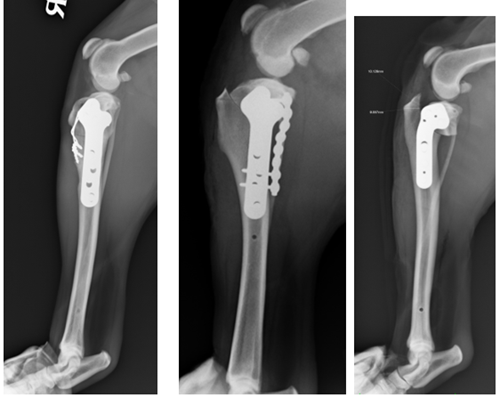
Cruciate ligament failure and concurrent patella luxation
Failure of the cruciate ligament leads to many planes of instability and can make an underlying patella luxation worse. Combining the cruciate ligament stabilisation and the patella luxation stabilisation is possible but defining the cause of the patella luxation is vital as always. In these cases The TPLO can be combined with a tibial crest transposition (TCT), a proximal tibial derotation, an internal brace suture (to stop internal rotation), a sulcoplasty to deepen the groove and can also be combined with a femoral osteotomy if need be.